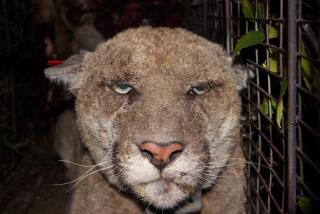Approach to transportation planning aims to keep animals from becoming roadkill
- Share via
LOGAN, UTAH — Wildlife researchers Patricia Cramer and John Bissonette scanned the bushes and brush amid patches of snow, looking for signs of mule deer.
Gleefully, Cramer kicked at a pile of droppings. “There you are,” she said. “I like to see that. It means the mule deer are coming through here.”
It also means, she added, that deer are using a corrugated metal underpass to get to the other side of a four-lane highway splitting Sardine Canyon without becoming part of a growing national statistic -- roadkill.
“We don’t like the slaughter of our wildlife,” Cramer said, giving a partial explanation for the pioneering work she and Bissonette have done to increase awareness of how states can reduce the number of vehicle-animal collisions. “This is pervasive across the United States, and it’s been under the radar screen.”
Bissonette and Cramer have completed the nation’s most comprehensive survey to identify nearly 600 wildlife crossings on land and 10,000 aquatic crossings.
Their federally funded research is spurring state departments of transportation and wildlife to work together to attempt to reduce the collisions that kill hundreds of people -- the 220 deaths in 2006 were the highest ever -- and injure thousands more people. In addition, hundreds of thousands of animals are killed. It all comes, according to the Insurance Institute for Highway Safety, at a cost of more than $1 billion.
“Our hope is we help develop a ‘culture of conservation’ in transportation planning across North America that begins to consider and accommodate wildlife and ecosystems across the roaded landscape,” Bissonette and Cramer’s report states.
And these crossings help preserve natural wildlife migration patterns.
Bissonette is a research scientist for the U.S. Geological Survey and head of the Utah Cooperative Fish and Wildlife Research Unit at Utah State University, where he works with university researcher Cramer.
Much of their research has been focused in the West. Cramer is involved in the Western Governors’ Assn.’s wildlife corridors initiative -- designed to develop recommendations for including wildlife considerations in road-building as well as oil and gas exploration and production.
“These collisions have long been underreported,” Bissonette said. “We are finding that putting together the transportation and wildlife departments results in engineers being more than willing to put their skills into solving this problem.”
Just outside Clam Lake, Wis., state officials are completing their first year of a new warning system that was installed to cut down on elk-vehicle collisions.
The state reintroduced elk in 1995 with a herd of 25 in the Chequamegon-Nicolet National Forest. The herd has grown to more than 130 animals and, according to state Department of Natural Resources biologist Laine Stowell, the top cause of elk deaths was motor vehicle collisions.
So, in 2006, officials from the state police and the state wildlife and transportation departments brainstormed and ultimately settled on a system of warning lights mounted on elk crossing signs along a four-mile stretch of Wisconsin Highway 77. The lights are triggered by radio collars, which are on about 70 of the elk in the herd, whenever the elk get near the road.
“Because elk are herd animals, you don’t have to put collars on them all and you still get good coverage,” Stowell said. “During the year before this program, we had five elk-vehicle collisions. This past year, we only had two.”
Several years ago, when U.S. Highway 53 was widened in the northern part of Wisconsin from two lanes to four, the medians were created much larger than normal -- up to half a mile long and several hundred feet wide. They also contain trees and brush because the road went through an area where wolves have been reintroduced. Officials told Cramer and Bissonette that a wolf had a litter of cubs in a den in one of the medians.
Charles Perino, a natural resources analyst for the Illinois Department of Transportation, said Illinois had three projects in the planning stages that would create spaces for wildlife to cross roads.
“This is a change in the way we do things,” he said. “And it’s a good thing.”
A 2003 study supported by the Insurance Institute concluded that getting people to drive slower in areas where animals cross the road was effective but that influencing driver behavior was difficult. The traditional crossing sign -- whether it is for deer, moose, elk or bear -- is generally ignored, the study said.
Other deterrents that have been tried include roadside lighting, spraying deer repellent, eliminating forage at the side of the road, and installing miles of fence -- a costly solution that is effective only where access to the roadway can be controlled.
Troy Jerman, an engineer in the Iowa Transportation Department, said the state was doubling its roadside fencing to 40 miles in 2007 at an installation cost of about $40,000 a mile.
“The ecologists aren’t so wild about it because we are interrupting the natural migration pattern,” he said. “But it is about 90% effective in keeping deer off the road.”
An Indiana system of reflectors that redirects vehicle headlights into deer alongside a stretch of the state’s toll road -- theoretically scaring the animals away -- reduced collisions by 20%, a state transportation spokeswoman said.
Cramer and Bissonette are advocates of underpasses and overpasses because they are the least disruptive to animal migration routes and feeding patterns. Fences, they contend, are not the answer.
Bissonette said that virtually all fence systems had escape hatches for animals that got on the highway side.
“There is no fence ever created that is animal-proof,” he said.
More to Read
Sign up for Essential California
The most important California stories and recommendations in your inbox every morning.
You may occasionally receive promotional content from the Los Angeles Times.










